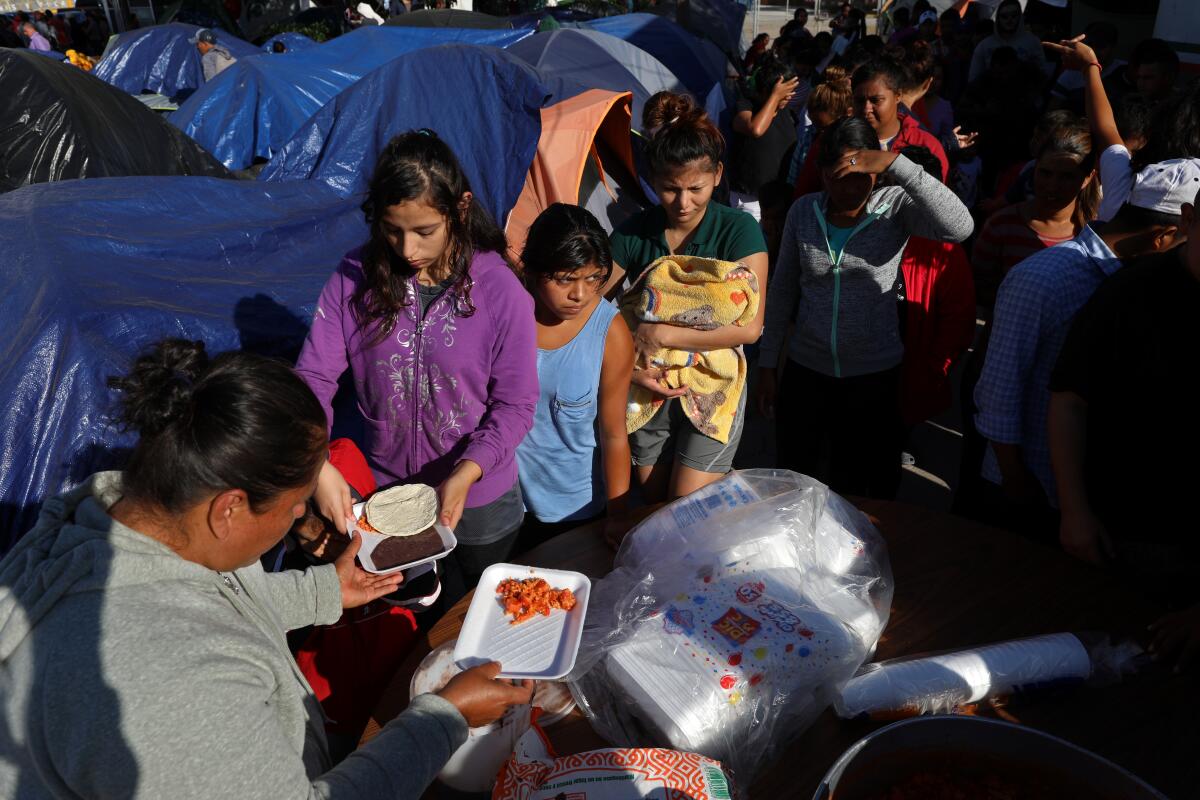Here’s what happens to the asylum seekers we turn away

- Share via
In June 1939, about 900 Jewish refugees sailed close to Florida on the St. Louis in hopes of finding protection in the United States. U.S. authorities refused to let the ship dock. Desperate passengers sent cables to President Franklin D. Roosevelt, who never responded. A State Department telegram stated that the passengers must “await their turns on the waiting list and qualify for and obtain immigration visas before they may be admissible in the United States.” Nearly all the passengers had already been refused admission to Cuba. Canada rejected them, too. They had no choice but to return to Europe, where 254 of the passengers were eventually killed in the Holocaust.
Eighty years later, a modern version of this tragedy takes place daily at our southern border. This time, most of these people are fleeing rape, assault, and death from the northern triangle of Central America — Honduras, El Salvador, and Guatemala — as well as political oppression in Cuba, Venezuela, and elsewhere. They are fleeing to save their lives and their children’s lives. They hope to find safety in the United States. When they get to America, U.S. authorities turn them around.
I spent a week recently in Juárez, Mexico, with four of my law students. We visited shelters across the city and its outskirts to provide pro bono legal services to some of the estimated 20,000 migrants there who are trying to apply for asylum in the U.S. We met political dissidents from Cuba who had been jailed and beaten for refusing to join party meetings, mothers from Central America who had survived excruciating years of domestic violence and fled to save their children’s lives, and fathers with the courage to resist the ever-increasing violence of gangs in their communities. Nearly all genuinely feared being harmed and killed in their home countries.
Why are they in Juárez? A slew of policy changes enacted over the past year by the Trump administration has made it nearly impossible for asylum seekers to enter the United States through the southern border. Among them is the Migrant Protection Protocols program, which requires asylum seekers who try to enter the United States through the southern border to remain in Mexico while their asylum cases are processed in U.S. immigration courts. Since last January, when the new protocols were put in place, more than 60,000 asylum seekers have been stranded in Mexico.
The new rules make it nearly impossible for asylum seekers to find lawyers who can represent them in immigration court. Hardly any lawyers are willing to cross into Juárez to represent asylum seekers. Given the complexity of immigration law and language and cultural barriers, the process of seeking asylum when someone is in the United States is hard enough. Requiring asylum seekers to remain in Mexico makes navigating the process virtually impossible. Ninety-six percent of individuals stranded in Mexico do not have a lawyer to help them apply for asylum.
Of the 29,309 cases that have been completed under MPP as of December 2019, just 187 people had been granted asylum — a reflection of the almost insurmountable barriers imposed by the new protocols. U.S. law requires asylum seekers to be given “credible fear” interviews to allow them into the U.S. while they go through the asylum process; MPP has eliminated that step.
While asylum seekers, including thousands of children and women, wait in Mexico they have become targets for vicious crimes by local and transnational gangs and cartels. According to a recent report from Human Rights First, there have been at least 816 publicly reported cases of murder, rape, torture, kidnapping, and other violent assaults, including 201 cases of children being kidnapped or nearly kidnapped. These numbers almost certainly understate the violence since many victims don’t report crimes committed against them for fear of reprisal.
When U.S. officials rejected the St. Louis, the horrors that would befall the passengers were foreseeable. Congress and the U.S. State Department eventually apologized for refusing to let in the refugees on board — but it was 70 years too late.
One year after the inception of MPP, we clearly see the dangers befalling asylum seekers forced to remain in Mexico. U.S. government officials know that these regions of the border are extremely dangerous. The U.S. State Department’s travel advisories warn U.S. citizens not to travel to some of the same Mexican border towns where American authorities send asylum seekers. These areas are designated as level 4 risks — the same danger assessment as for Afghanistan, Iraq, and Syria.
The Trump policy is not only inhumane and dangerous, it is also illegal. Under U.S. immigration law, asylum seekers are not to be turned away at the border when they have credible fears of persecution. As the union representing DHS asylum officers explained, “MPP abandons our tradition of providing a safe haven to the persecuted and violates our international and domestic legal obligations.”
We can’t turn a blind eye to the daily tragedies inflicted by Migrant Protection Protocols. The Asylum Seeker Protection Act, which would prohibit the use of federal funds to carry out MPP, has been pending in Congress for months. It’s time to uphold our nation’s core commitment to protecting those seeking safety in this country.
Elora Mukherjee is the Jerome L. Greene Clinical Professor of Law at Columbia Law School and director of its immigrants’ rights clinic.
More to Read
A cure for the common opinion
Get thought-provoking perspectives with our weekly newsletter.
You may occasionally receive promotional content from the Los Angeles Times.









